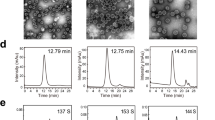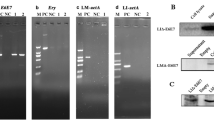Abstract
We are developing immunization strategies against cervical carcinoma and premalignant disease, based on the use of recombinant Semliki Forest virus (SFV) encoding the oncoproteins E6 and E7 from high-risk human papilloma viruses (HPV). Thus far, protein-based, as well as genetic immunization studies have demonstrated low to moderate cellular immune responses against E6 and E7. To improve these responses, we modified the structure and expression level of the E6 and E7 proteins produced by the SFV vector. Specifically, a construct was generated encoding a fusion protein of E6 and E7, while furthermore a translational enhancer was included (enhE6,7). Infection of cells with recombinant SFV-enhE6,7 resulted in the production of large amounts of the E6,7 fusion protein. The fusion protein was more stable than either one of the separate proteins. Immunization of mice with SFV-enhE6,7 resulted in strong, long-lasting HPV-specific cytotoxic T lymphocyte responses. Tumor challenge experiments in mice demonstrated that immunization with SFV-enhE6,7 resulted in prevention of tumor outgrowth and subsequent protection against tumor re-challenge.
This is a preview of subscription content, access via your institution
Access options
Subscribe to this journal
Receive 12 print issues and online access
$259.00 per year
only $21.58 per issue
Buy this article
- Purchase on Springer Link
- Instant access to full article PDF
Prices may be subject to local taxes which are calculated during checkout







Similar content being viewed by others
References
Münger K., Scheffner M., Huibregtse J.M., Howley P.M. . Interactions of HPV E6 and E7 with tumor suppressor gene products Cancer Surv 1992 12: 197 197
Porreco R. et al. Gynecological malignancies in immunosuppressed organ homograft recipients Obstet Gynecol 1975 45: 359 359
Johnson J.C. et al. High frequency of latent and clinical human papillomavirus cervical infections in immunocomprised human immunodeficiency virus-infected women Obstet Gynecol 1992 79: 321 321
De Bruijn M.L. et al. Immunization with human papillomavirus type 16 (HPV16) oncoprotein-loaded dendritic cells as well as protein in adjuvant induces MHC class I-restricted protection to HPV16-induced tumor cells Cancer Res 1988 58: 724 724
Daemen T. et al. Genetic immunization against cervical carcinoma: induction of cytotoxic T lymphocyte activity with a recombinant alphavirus vector expressing human papillomavirus type 16 E6 and E7 Gene Therapy 2000 7: 1859 1859
Feltkamp M.C. et al. Cytotoxic T lymphocytes raised against a subdominant epitope offered as a synthetic peptide eradicate human papillomavirus type 16-induced tumors Eur J Immunol 1995 25: 2638 2638
Jochmus I. et al. Specificity of human cytotoxic T lymphocytes induced by a human papillomavirus type 16 E7-derived peptide J Gen Virol 1997 78: 1689 1689
Boursnell M.E.G. et al. Construction and characterization of a recombinant vaccinia expressing human papillomavirus proteins for immunotherapy of cervical cancer Vaccine 1996 14: 1485 1485
Chen L. et al. Induction of cytotoxic T lymphocytes specific for a syngeneic tumor expressing the E6 oncoprotein of human papillomavirus type 16 J Immunol 1992 148: 2617 2617
Chu N.R. et al. Immunotherapy of a human papillomavirus (HPV) type 16 E7-expressing tumour by administration of fusion protein comprising Mycobacterium bovis bacille Calmette-Guerin (BCG) hsp65 and HPV16 E7 Clin Exp Immunol 2000 121: 216 216
Lin K.Y. et al. Treatment of established tumors with a novel vaccine that enhances major histocompatibility class II presentation of tumor antigen Cancer Res 1996 56: 21 21
Liu D.W. et al. Recombinant adeno-associated virus expressing human papillomavirus type 16 E7 peptide DNA fused with heat shock protein DNA as a potential vaccine for cervical cancer J Virol 2000 74: 2888 2888
Thornburg C., Boczkowski D., Gilboa E., Nair S.K. . Induction of cytotoxic T lymphocytes with dendritic cells transfected with human papillomavirus E6 and E7 RNA: implications for cervical cancer immunotherapy J Immunother 2000 23: 412 412
Berglund P. et al. Semliki Forest virus expression system: production of conditionally infectious recombinant particles Biotechnology NY 1993 11: 916 916
Klimp A.H. et al. Activation of peritoneal cells upon in vivo transfection with a recombinant alphavirus expressing GM-CSF Gene Therapy 2001 8: 300 300
Liljeström P., Garoff H. . A new generation of animal cell expression vectors based on the Semliki Forest virus replicon Biotechnology NY 1991 9: 1356 1356
Zhou X. et al. Generation of cytotoxic and humoral immune reponses by nonreplicative recombinant Semliki Forest virus Proc Natl Acad Sci USA 1994 92: 3009 3009
Borchers A. et al. E7-specific cytotoxic T cell tolerance in HPV-transgenic mice Arch Virol 1999 144: 1539 1539
Doan T. et al. Human papillomavirus type 16 E7 oncoprotein expressed in peripheral epithelium tolerizes E7-directed cytotoxic T-lymphocyte precursors restricted through human (and mouse) major histocompatibility complex class I alleles J Virol 1999 73: 6166 6166
Glasgow G.M. et al. The Semliki Forest virus vector induces p53-independent apoptosis J Gen Virol 1998 79: 2405 2405
Kohno A. et al. Semliki Forest virus-based DNA expression vector-transient protein production followed by cell death Gene Therapy 1998 5: 415 415
Restifo N.P. . Building better vaccines: how apoptotic cell death can induce inflammation and activate innate and adoptive immunity Curr Opin Immunol 2000 12: 597 597
Ying H. et al. Cancer therapy using a self-replicating RNA vaccine Nat Med 1999 5: 823 823
Braspenning J. et al. A general purification protocol for E7 proteins from high- and low-risk human papillomavirus types expressed in the yeast Schizosaccharamyces pombe Protein Express Purif 1997 10: 192 192
Gileadi U. et al. Generation of an immunodominant CTL epitope is affected by proteasome subunit composition and stability of the antigenic protein J Immunol 1999 163: 6045 6045
Grant E.P., Michalek M.T., Goldberg A.L., Rock K.L. . Rate of antigen degradation by the ubiquitin-proteasome pathway influences MHC class I presentation J Immunol 1995 155: 3750 3750
Shi W. et al. Human papillomavirus type 16 E7 DNA vaccine: mutation in the open reading rame of E7 enhances specific cytotoxic T-lymphocyte induction and antitumor activity J Virol 1999 73: 7877 7877
Tobery T.W., Siliciano R.F. . Targeting of HIV-1 antigens for rapid intracellular degradation enhances cytotoxic T lymphocyte (CTL) recognition and the induction of de novo CTL responses in vivo after immunization J Exp Med 1997 185: 909 909
Townsend A. et al. Defective presentation to class I-restricted cytotoxic T lymphocytes in vaccinia-infected cells is overcome by enhanced degradation of antigen J Exp Med 1988 168: 1211 1211
Alberts M.L., Sauter B., Bhardwaj N. . Dendritic cells acquire antigen from apoptotic cells and induce class I-restricted CTLs Nature 1998 392: 86 86
Rock K.L. . A new foreign policy: MHC class I molecules monitor the outside world Immunol Today 1996 17: 131 131
Sjöberg E.M., Suomalainen M., Garoff H. . A significantly improved Semliki Forest virus expression system based on translation enhancer segments from the viral capsid gene Biotechnol NY 1994 12: 1127 1127
Colmenero P., Liljestrom P., Jondal M. . Induction of P815 tumor immunity by recombinant Semliki Forest virus expressing the P1A gene Gene Therapy 1999 6: 1728 1728
Ji H. et al. Antigen-specific immunotherapy for murine lung metastatic tumors expressing human papillomavirus type 16 E7 oncoprotein Int J Cancer 1998 78: 41 41
Ossendorp F. et al. Specific T helper cell requirement for optimal induction of cytotoxic T lymphocytes against major histocompatibility complex class II negative tumors J Exp Med 1998 187: 693 693
Ossendorp F. et al. Importance of CD4+ T helper cell responses in tumor immunity Immunol Lett 2000 74: 75 75
Van Bergen J. et al. Get into the groove! Targeting antigens to MHC class II Immunol Rev 1999 172: 87 87
Cardin R.D., Brooks J.W., Sarawar S.R., Doherty P.C. . Progressive loss of CD8+ T cell-mediated control of a herpesvirus in the absence of CD4+ T cells J Exp Med 1996 184: 863 863
Matoubian M., Concepcion R.J., Ahmed R. . CD4+ T cells are required to sustain CD8+ cytotoxic T-cell responses during chronic viral infection J Virol 1994 68: 8056 8056
Smerdou C., Liljeström L. . Two-helper RNA system for production of recombinant Semliki Forest virus particles J Virol 1999 73: 1092 1092
Berglund P. et al. Outcome of immunization of cynomolgus monkeys with recombinant Semliki Forest virus encoding human immunodeficiency virus type 1 envelope protein and challenge with a high dose of SHIV-4 virus AIDS Res Hum Retrovir 1997 13: 1487 1487
Mossman S.P. et al. Protection against lethal simian immunodeficiency virus SIVsmmPBj14 disease by a recombinant Semliki Forest virus gp160 vaccine and by a gp120 subunit vaccine J Virol 1996 70: 1953 1953
Notka F. et al. Construction and characterization of recombinant VLPs and Semliki-Forest virus live vectors for comparative evaluation in the SHIV monkey model Biol Chem 1999 380: 341 341
Barbosa M.S. et al. The region of the HPV E7 oncoprotein homologous to adenovirus E1a and Sv40 large T antigen contains separate domains for Rb binding and casein kinase II phosphorylation EMBO J 1990 9: 153 153
Laassri M. et al. Cloning of E6 and E7 genes of human papilloma virus type 18 and transformation potential of E7gene and its mutants Virus Genes 1999 18: 139 139
Smits P.H.M., Smits H.L., Jebbink M.F., Ter Schegget J. . The short arm of chromosome 11 likely is involved in the regulation of the human papillomavirus type 16 early enhancer-promoter and in the suppression of the transforming activity of the viral DNA Virol 1990 176: 158 158
Miyahira Y. et al. Quantification of antigen specific CD8+ T cells using an ELISPOT assay J Immunol Meth 1995 181: 45 45
Acknowledgements
We thank Dr AGJ van der Zee, Dr Hollema and Dr P Liljeström for advice and stimulating discussions and B Dontje for expert technical assistance. Part of this work was supported by the EU Biotechnology and Biomedicin and Health programmes.
Author information
Authors and Affiliations
Rights and permissions
About this article
Cite this article
Daemen, T., Regts, J., Holtrop, M. et al. Immunization strategy against cervical cancer involving an alphavirus vector expressing high levels of a stable fusion protein of human papillomavirus 16 E6 and E7. Gene Ther 9, 85–94 (2002). https://doi.org/10.1038/sj.gt.3301627
Received:
Accepted:
Published:
Issue Date:
DOI: https://doi.org/10.1038/sj.gt.3301627
Keywords
This article is cited by
-
Cancer vaccine strategies using self-replicating RNA viral platforms
Cancer Gene Therapy (2023)
-
An alphavirus-based therapeutic cancer vaccine: from design to clinical trial
Cancer Immunology, Immunotherapy (2019)
-
Antigen design enhances the immunogenicity of Semliki Forest virus-based therapeutic human papillomavirus vaccines
Gene Therapy (2015)
-
Alphavirus-based Vaccines Encoding Nonstructural Proteins of Hepatitis C Virus Induce Robust and Protective T-cell Responses
Molecular Therapy (2014)
-
Viral vector-based prime-boost immunization regimens: a possible involvement of T-cell competition
Gene Therapy (2008)



